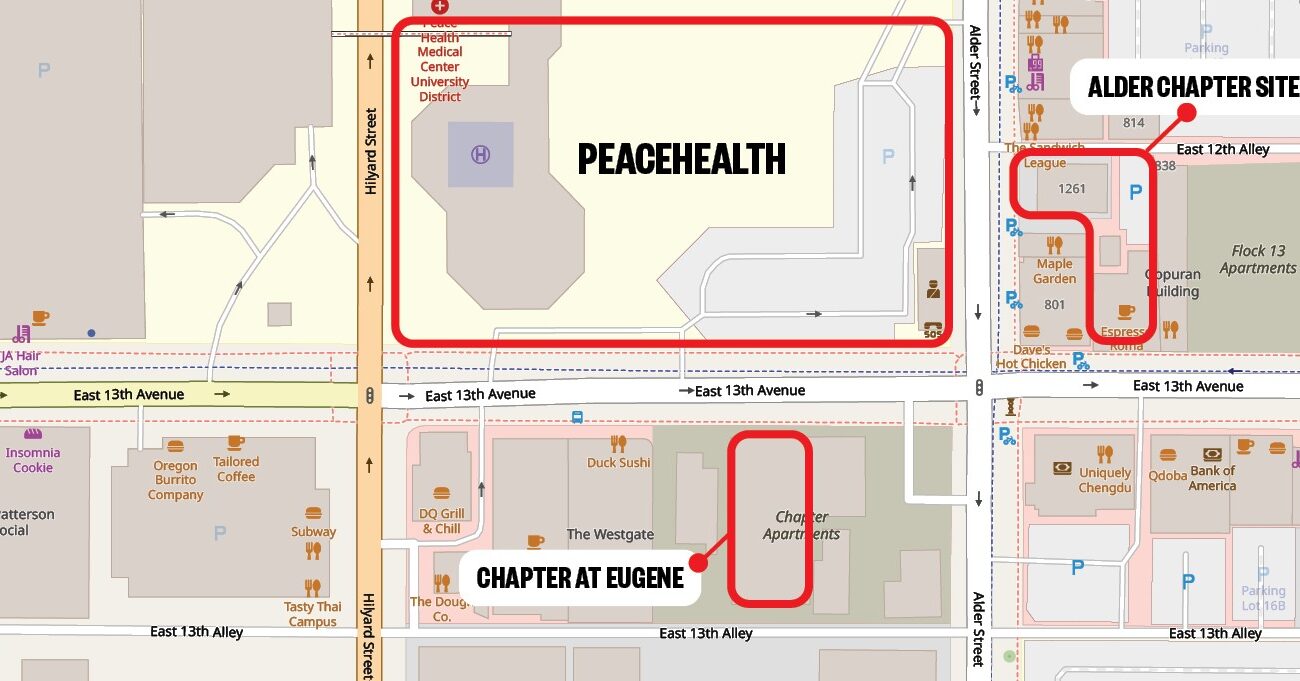Major Chicago-based real estate developer CRG figures the key to success in Eugene’s increasingly competitive student housing market is building high-rises as close as possible to the University of Oregon campus.
No surprise then, the company says it will begin construction in September of a 15-story, 491-bed high-rise at Alder Street and 13th Avenue, less than a block from the UO’s main entrance.
CRG may need every marketing edge it can get, given the many large new student apartment complexes within walking distance of the UO that have pushed campus-area rental vacancies to their highest in many years. Owners are offering renters “aggressive incentives,” including gift certificates, laundry credits and one to two months rent free, a study found last fall.
Building close to the UO carries a price. CRG is having to buy and demolish three old low-rise buildings — including one that houses the Espresso Roma coffee shop on 13th — to clear the company’s chosen footprint. The old buildings are valued at nearly $3 million. The company’s contractor has already applied for demolition permits from the city.
The project — dubbed Alder Chapter — is CRG’s second in Eugene. Its first, the recently completed 12-story Chapter at Eugene student tower on 13th, is half a block west of the Alder Chapter site. To prepare the site, CRG bought and, in January 2023, razed the $2 million two-story Excelsior Inn hotel and restaurant.
CRG likes 13th and Alder because it’s on the retail corridor leading into campus, and is near busy campus spots, including the Knight Library, the College of Education and the Student Rec Center, says JJ Smith, executive vice president of CRG.
Alder Chapter should be done by August 2027, Smith tells Eugene Weekly.
Thousands of beds
Private-sector developers have added more than a half-dozen big student housing complexes near the UO totaling about 3,000 beds in the last few years, begging the question of whether there are enough students to fill the rooms.
Smith indicates he’s confident there’s demand for Alder Chapter.
But campus-area rental vacancies have been rising, says Zoe Swartz, an appraiser with Eugene-based Viewpoint Appraisals.
In its fall 2024 survey, the appraisal firm found an 8.25 percent vacancy rate for campus-area rentals, the highest in the company’s 16 years of surveys. The vacancy tallies don’t include new complexes that have been open only about a year and are still filling up, or “stabilizing.” If those were included, vacancy rates would be higher, Swartz says.
“The majority of the increased vacancy has been in the newest construction projects as they stabilize and compete with one another,” Swartz tells Eugene Weekly.
But the Eugene market is “not significantly over-supplied,” she adds. “We are likely just looking at a more short-term impact as a result of the atypically high influx of new units, as a large number of units in a short time frame will take time to absorb.”
Some students say they’ve not seen rents soften as the large purpose-built student housing complexes have come on line.
Laur Nystrom, a third-year psychology major at the UO, says they are moving in August to a house with roommates to escape the high rents charged at student housing complexes.
“I’m sick of living in student housing. It’s loud. Your level of independence is really limited, and it’s hard to have access to the outside,” Nystrom says. And “it’s become so expensive that I can’t afford to do it anymore.”
Enrollment plateau?
There are big financial implications for owners, students and non-student renters.
Surges in UO enrollment from 1999 to 2012 sparked a construction rush by apartment developers. Since then, however, UO enrollment has leveled out, fluctuating between 21,800 and 24,600, with the last few years hovering toward the higher end. The UO says it expects slow enrollment growth in coming years. Yet housing developers from around the nation have piled in, building new mid- and high-rise student-oriented projects.
About a quarter of UO students live in university-owned housing. The UO is expanding its inventory by building an 870-bed dorm to open in 2027. The “purpose-built” large private-sector student apartment complexes can accommodate one third of UO students, Smith says. That leaves the remaining roughly 40 percent of students living in smaller, more general-purpose private-sector housing.
The big new student-apartment complexes have had “very little impact on the older, smaller complexes or single-family homes. Occupancy for those remains high and more stable than the newer projects,” says Swartz. “More non-students are renting some of the older-construction apartments in more traditionally campus locations, as they remain some of the more affordable rents.”
For Alder Chapter, CRG will knock down the single-story retail building that has been the longtime home to Espresso Roma, as well as a shuttered two-story retail building on Alder that housed the Maple Garden Restaurant and a three-story nine-apartment house on Alder. All three are owned by investors. No deeds have yet been filed that show they have sold to CRG.
Bricks $ Mortar is a column anchored by Christian Wihtol, who worked as an editor and writer at The Register-Guard in Eugene 1990-2018, much of the time focused on real estate, economic development and business. Reach him at Christian@EugeneWeekly.com.
Eve Weston contributed reporting to this story.
